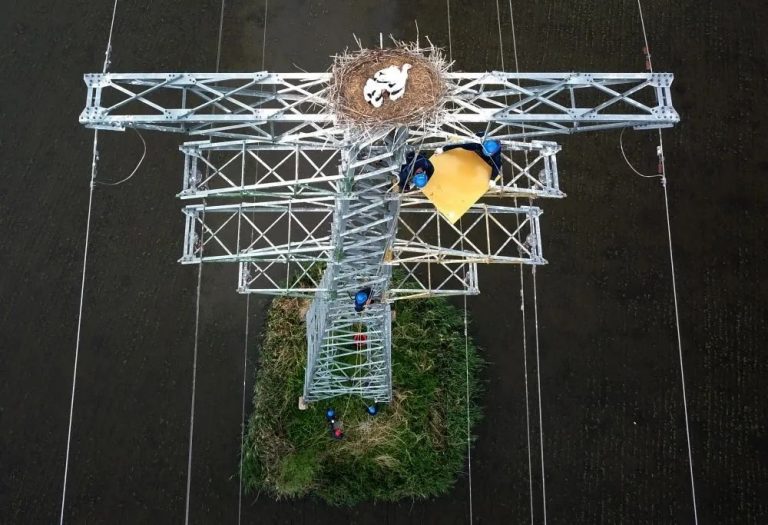
By Ding Yiting, China is one of the countries with the richest avian resources in the world and serves as a crucial pathway for the transboundary migration of migratory birds.
With the largest power system globally, China boasts a transmission network spanning over 2.26 million kilometers of 35 kilovolts and above. How can the country ensure a secure power supply while also providing a safe habitat for birds to inhabit and reproduce around transmission towers? People’s Daily journalists had an interview to find the answer.
With swift acceleration and a sharp dive, a raptor seized its prey. After finishing the “meal,” it hovered momentarily and landed on a transmission tower, which 110-kilovolt lines run through. At the top of the tower, there was an artificial nest woven from vines, serving as the “home” for this formidable bird.
It was in Zoige county, Aba Tibetan and Qiang autonomous prefecture, southwest China’s Sichuan province. In this region, situated at an average altitude of around 3,500 meters, the staff of the Aba branch of State Grid Sichuan Electric Power Company has built several artificial nests for falcons, black kites, and other raptors.
“The Zoige wetland is abundant in water and grass, providing a habitat for over 200 species of birds. In the past, these birds used to build nests on transmission towers, using materials such as iron wire and cow hair. However, bird-related faults have become the third leading cause of line tripping, after lightning strikes and external damage,” said Liu Yong, director of the digitalization department of the Aba branch of State Grid Sichuan Electric Power Company.
There aren’t too many tall trees in the grassland, which makes transmission towers the preferred nesting sites for many bird species. In the past, local authorities attempted to deter birds from perching on the towers by installing repellent devices, but the effect was limited. Pondering over this issue, power workers came up with the idea that instead of trying to prevent birds, they should create artificial bird nests to guide the birds toward safer locations for nesting.
Last April, the Aba branch installed 32 artificial bird nests and 14 sets of high-definition video devices along a 110 kV transmission line. Additionally, partial insulation treatment was applied to the tower structure, to avoid large birds from coming into contact with exposed live wires while perching on the top of the towers.
“Our artificial bird nests are spacious and comfortable, and the locations of installation were carefully chosen. They are typically placed in non-electrified sections of the transmission towers, guiding birds to engage in safe activities within the designated areas, and ensuring the safety of both the birds and the power grid,” Liu explained.
According to officials from State Grid Corporation of China, since 2016, the corporation has launched a public welfare project aiming to study the habits of rare raptors around the transmission lines in grassland areas on plateaus, develop artificial bird nests suitable for different regions, and label each nest with a unique “house number” for easy monitoring and management.
So far, the project has been extended to the grassland areas of six provincial-level regions, including the Inner Mongolia autonomous region, Sichuan Province, Xizang autonomous region, Gansu Province, Qinghai Province, and Xinjiang Uygur autonomous region.
Over 5,200 artificial bird nests have been installed, resulting in the successful hatching of nearly 4,000 chicks. This initiative has effectively protected the grassland ecology on Chinese plateaus.
Many transmission lines are situated in remote areas with limited accessibility, long distances, and dispersed locations, thus it is necessary to enhance protection efficiency and accuracy. Jiangsu province has utilized technologies such as big data to develop nest site prediction models, which have proven to be highly effective.
The Tiaozini wetland in Yancheng, Jiangsu province serves as a crucial stopover point on the East Asian-Australasian flyway for migratory birds. From November to the next June each year, a large number of bird species, including the oriental white stork, a first-class nationally protected animal, choose to stay or winter in this area.
At the transmission operation and maintenance center of State Grid Yancheng Power Supply Company, a large screen displayed real-time footage from a transmission tower located over 90 kilometers away near the Tiaozini wetland. In the footage, a pair of oriental white storks with white feathers and fiery red legs were busy constructing a new nest.
“This is a system that monitors biodiversity around the power grid. Whenever a nest is detected by the cameras, drones are automatically deployed to inspect and capture images. Once our employees confirm the presence of rare bird species like the oriental white stork, we immediately install protective equipment on-site. This not only enhances the effectiveness of protection but also reduces petrol costs,” said Song Yanqiu, a staff member of the digital technology department of State Grid Yancheng Power Supply Company.
Song told People’s Daily that with the monitoring system, the utilization rate of bird protection devices on the transmission lines has increased by approximately 20 percent. This system allows for observing and safeguarding the birds without causing disturbance or intervention.
In Anhui province, power grid workers have launched a biomimetic light emission project for birds, utilizing visual micro-cameras to identify birds and emit ecological light beams to guide their flight paths without causing harm.
In Shandong province, a new type of composite insulation bird guard has been developed, significantly reducing the rate of bird-related faults in power grids.
The continuous application of technological methods has yielded more effective results in the protection of power lines and birds.
Since 2021, State Grid Corporation of China has implemented the bird-protecting project at 23 sites across 18 provincial-level regions, including Tianjin, Jiangsu, Anhui, Jiangxi, and Shandong. This project aims to promote multi-party collaboration, technological innovation, and patrol and rescue efforts, resulting in the successful rescue of over 13,000 birds protected at various levels.










